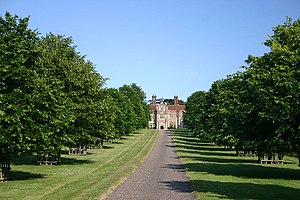Coldham Hall
| Coldham Hall | |
|---|---|

Coldham Hall
|
|
| Location | Coldham Hall Lane, Stanningfield, Suffolk, England |
| Coordinates | 52°10′10″N 0°43′27″E / 52.1694°N 0.7243°ECoordinates: 52°10′10″N 0°43′27″E / 52.1694°N 0.7243°E |
| Built | 1574 |
| Built for | Robert Rookwood |
|
Listed Building – Grade I
|
|
| Official name: Coldham Hall | |
| Designated | 14 July 1955 |
Coldham Hall is a Grade I listed building, built in 1574, that is located in the parish of Stanningfield in Suffolk. The Hall is very close to the village of Lawshall, and part of the Coldham estate is located within this parish.
Coldham Hall is a large Tudor country house that was constructed in 1574 for Sir Robert Rookwood (or Rokewood) of Stanningfield. A notable feature of this two-storey building is the great hall, with a long gallery in the roof space some 32 metres long, running from east to west. Internal alterations undertaken around 1770 include a Roman Catholic chapel with delicate plasterwork, leading from the long gallery.
Mid-nineteenth century alterations, including loggias on the east and south side, are now removed, but various window alterations at the rear and a service wing at the north end remain. The house was restored around 1980.
Following its construction by Robert Rookwood in 1574, Coldham Hall remained the property of the Rookwood family for almost three centuries, until 1869.
The Hall has had a number of famous residents including Ambrose Rookwood who was involved in the Gunpowder plot and was executed in 1605. The Rookwood family continued in the Roman Catholic faith, as shown by the two chapels and several priest holes at Coldham. A remarkable feature of the history of Stanningfield and Lawshall has been the continuity of Roman Catholicism from the Middle Ages to the present day, in a predominantly Protestant area.
While the property remained in the Rookwood family until 1869, the estate passed through the female line to the Gages of Hengrave and was let to a tenant, Robert Taylor in the 1840s. In 1869 the estate was sold to Richard Holt-Lomax, whose family held it until 1893.
The purchaser in 1893 was Colonel Henry Trafford-Lawson who developed Coldham as a shooting estate, enlarging old clumps of woodland and planting new blocks, some very close to the Hall. After the death of the Colonel's son, John Trafford-Lawson, in the First World War, the Coldham estate was purchased in 1918 by Colonel Everard Hambro, who lived there until his death in 1952.
...
Wikipedia

